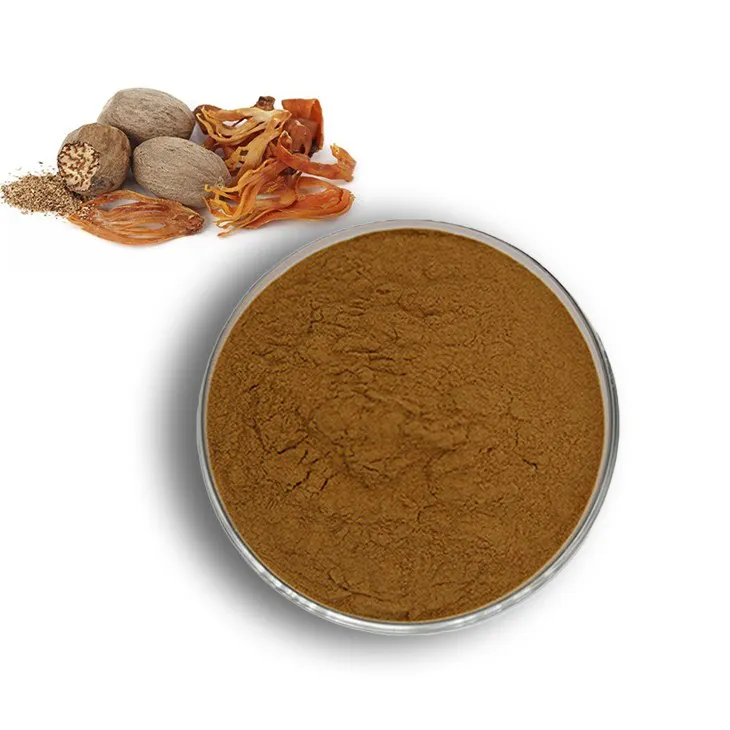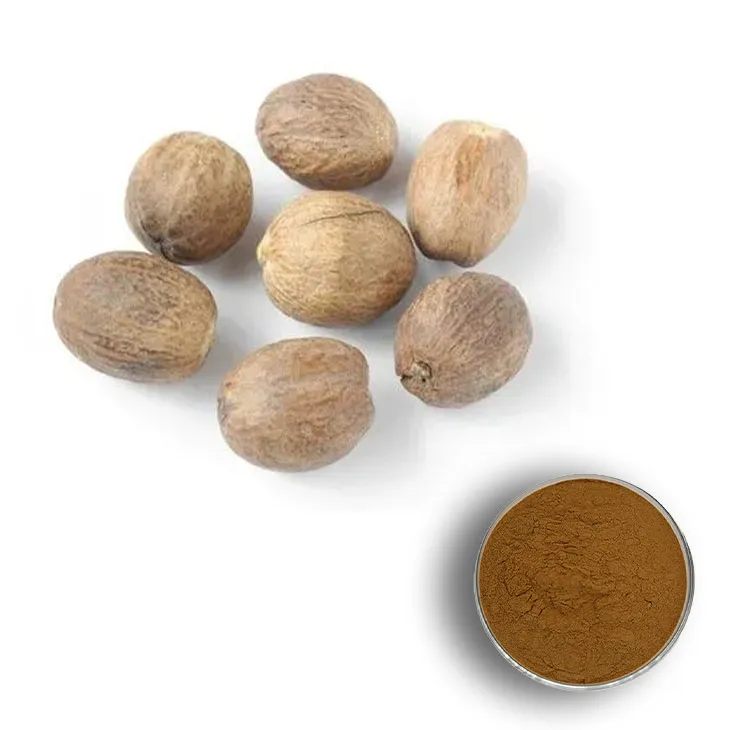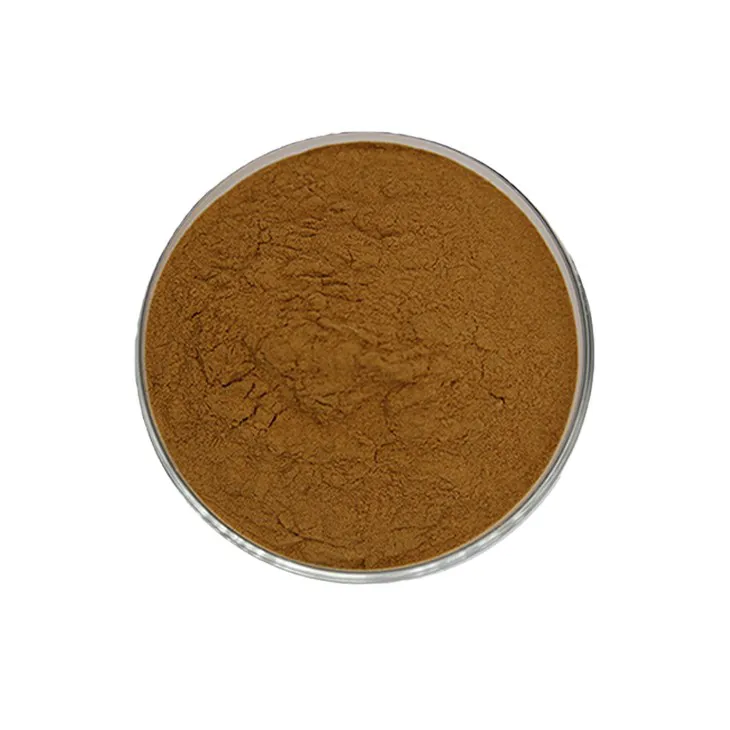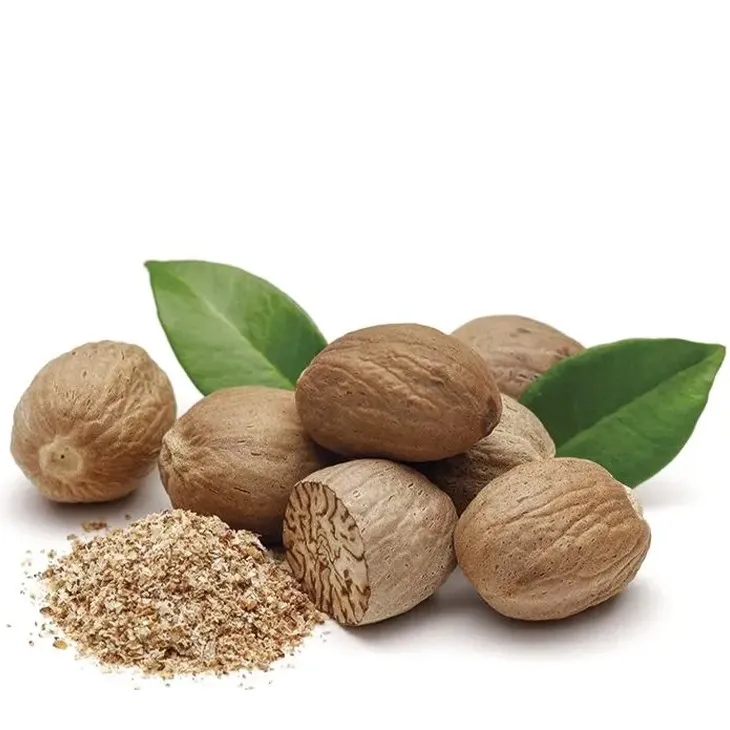- 0086-571-85302990
- sales@greenskybio.com
The process of extracting myristicin from nutmeg extract.
2024-11-29

1. Introduction
Nutmeg, a spice derived from the seed of the Myristica fragrans tree, has been used for centuries in cooking, traditional medicine, and perfumery. Its extract contains a variety of compounds, among which myristicin is an important one. Myristicin has shown potential in various applications such as in the pharmaceutical and flavor industries. However, extracting myristicin from Nutmeg Extract is a complex process that requires careful consideration of multiple factors to ensure high yield, purity, and safety.

2. Preparation of Nutmeg Extract
2.1 Selection of Nutmeg
The quality of the nutmeg used for extraction is crucial. High - quality, fresh nutmeg should be selected. Nutmegs that are free from mold, pests, and physical damage are preferred. The origin of the nutmeg also plays a role, as different regions may produce nutmegs with slightly different chemical compositions. For example, nutmeg from Indonesia is well - known for its rich flavor and potentially higher content of bioactive compounds.
2.2 GrindingOnce the appropriate nutmeg is selected, it needs to be ground into a fine powder. This increases the surface area of the nutmeg, allowing for more efficient extraction. A grinder with a suitable mesh size is used to ensure that the powder is fine enough. However, care should be taken not to over - grind, as this may lead to the loss of volatile compounds or the generation of excessive heat, which could affect the quality of the extract.
2.3 Solvent SelectionThe choice of solvent for the extraction of Nutmeg Extract is a critical step. Common solvents used include ethanol, hexane, and ethyl acetate.
- Ethanol: It is a relatively safe and widely available solvent. Ethanol has the advantage of being able to dissolve a wide range of compounds present in nutmeg, including polar and semi - polar substances. It is also miscible with water, which can be beneficial if further purification steps involving aqueous solutions are planned. However, ethanol may also extract some unwanted compounds along with the desired ones.
- Hexane: Hexane is a non - polar solvent, which is particularly effective in extracting non - polar compounds such as lipids and certain volatile oils from nutmeg. It has a low boiling point, which makes it easy to remove during the subsequent evaporation step. However, hexane is highly flammable and requires careful handling in a well - ventilated area.
- Ethyl acetate: This solvent has intermediate polarity. It can extract a variety of compounds from nutmeg, including some flavor - related and bioactive substances. Ethyl acetate has a relatively pleasant smell and is less toxic compared to some other solvents. It also has a moderate boiling point, which is suitable for solvent removal in later steps.
After the solvent is selected, the ground nutmeg powder is mixed with the solvent in an appropriate ratio. This mixture is then stirred or shaken for a certain period to allow the compounds in the nutmeg to dissolve into the solvent. The extraction time and temperature can affect the efficiency of the extraction.
- Extraction Time: Longer extraction times generally result in higher yields of nutmeg extract. However, if the extraction time is too long, it may also lead to the extraction of more impurities. A typical extraction time can range from a few hours to overnight, depending on the nature of the solvent and the desired yield.
- Extraction Temperature: Increasing the extraction temperature can accelerate the dissolution of compounds into the solvent. However, high temperatures can also cause the degradation of some thermally - labile compounds in nutmeg. Therefore, a moderate temperature, usually in the range of room temperature to slightly above (e.g., 25 - 40 °C), is often used.

3. Separation of Myristicin from Nutmeg Extract
3.1 Distillation
Distillation is one of the common methods for separating myristicin from nutmeg extract.
- The nutmeg extract, which is a mixture of solvents and dissolved compounds, is placed in a distillation apparatus. The apparatus typically consists of a flask, a condenser, and a receiving flask.
- The mixture is heated gradually. As the temperature rises, the solvents and volatile compounds start to vaporize. Different components have different boiling points, and they will vaporize at different temperatures.
- Myristicin has a relatively high boiling point compared to some of the other volatile components in the nutmeg extract. By carefully controlling the temperature, it is possible to separate myristicin from the lower - boiling - point solvents and other volatile substances. The vapors are condensed in the condenser and collected in the receiving flask.
Another approach for separating myristicin is through solvent extraction methods.
- Liquid - Liquid Extraction: This method involves using two immiscible solvents. For example, if the nutmeg extract is initially in an ethanol - based solvent, a non - polar solvent like hexane can be added. Myristicin, which has some non - polar characteristics, will partition between the two solvents. By carefully adjusting the ratio of the two solvents and performing multiple extraction steps, it is possible to enrich myristicin in one of the solvent phases.
- Counter - current Extraction: This is a more advanced form of solvent extraction. In this method, two immiscible solvent streams flow in opposite directions through a column or a series of extraction vessels. The nutmeg extract is introduced into one of the solvent streams, and as the solvents flow, the components in the extract are continuously partitioned between the two solvents. Myristicin can be selectively transferred to one of the solvent phases, depending on its solubility characteristics. Counter - current extraction can achieve a higher degree of separation compared to simple liquid - liquid extraction.

4. Purification of Myristicin
After the initial separation, the myristicin - containing fraction still may contain impurities. Therefore, purification steps are necessary to obtain high - purity myristicin. 4.1 Crystallization
Crystallization is a commonly used purification method.
- The myristicin - containing solution is concentrated by evaporating some of the solvent. This increases the concentration of myristicin in the solution.
- The concentrated solution is then cooled slowly. As the temperature decreases, myristicin, which has a characteristic solubility behavior with respect to temperature, will start to crystallize out of the solution.
- The crystals are then separated from the mother liquor by filtration. The crystals can be further washed with a small amount of cold solvent to remove any adhering impurities.
Chromatography is a powerful purification technique.
- Column Chromatography: In column chromatography, a column is filled with a stationary phase, such as silica gel or alumina. The myristicin - containing sample is loaded onto the top of the column, and a mobile phase (a solvent or a mixture of solvents) is passed through the column. Different components in the sample will interact differently with the stationary and mobile phases, and thus will move through the column at different rates. Myristicin can be selectively eluted from the column, separating it from other impurities.
- High - Performance Liquid Chromatography (HPLC): HPLC is a more advanced form of chromatography. It uses a high - pressure pump to force the mobile phase through a column packed with a very fine - grained stationary phase. This allows for much higher resolution and more precise separation of myristicin from other components. HPLC can be used to obtain highly pure myristicin, but it requires expensive equipment and skilled operators.

5. Safety Considerations in the Extraction Process
5.1 Solvent Safety
As mentioned earlier, solvents such as hexane are highly flammable. Adequate ventilation in the extraction area is essential to prevent the buildup of flammable vapors. Workers should also be trained in proper handling procedures, including the use of appropriate fire - extinguishing equipment in case of a fire. Ethanol, although less flammable than hexane, is also a flammable substance and requires similar safety precautions.
5.2 ToxicitySome solvents and compounds in nutmeg extract may be toxic. For example, excessive exposure to hexane can cause nerve damage. Therefore, proper personal protective equipment (PPE), such as gloves and goggles, should be worn during the extraction process. Additionally, waste solvents should be disposed of according to environmental regulations to prevent pollution and potential harm to human health.
5.3 Thermal HazardsDuring distillation and other heating processes, there is a risk of burns from hot surfaces and equipment. Workers should be trained to handle heated apparatus safely and use appropriate heat - resistant gloves and other protective gear.
6. Quality Control in the Extraction of Myristicin
6.1 Purity Analysis
To ensure the quality of the extracted myristicin, purity analysis is necessary. Techniques such as gas chromatography - mass spectrometry (GC - MS) can be used to identify and quantify the components in the myristicin sample. This helps to determine the percentage of myristicin in the final product and the presence of any impurities.
6.2 Yield CalculationCalculating the yield of myristicin is important for process optimization. The yield is calculated by comparing the amount of myristicin obtained at the end of the extraction process with the amount of myristicin theoretically present in the original nutmeg. This helps in evaluating the efficiency of the extraction and separation methods used.
FAQ:
What are the initial steps in preparing nutmeg extract for myristicin extraction?
The initial steps in preparing nutmeg extract for myristicin extraction likely involve sourcing high - quality nutmeg. This may include ensuring that the nutmeg is properly dried and ground to an appropriate consistency. Grinding the nutmeg helps to increase the surface area, which can enhance the efficiency of subsequent extraction steps. Additionally, it may be necessary to clean the nutmeg to remove any impurities or foreign matter that could interfere with the extraction process.
How does distillation work in the extraction of myristicin from nutmeg extract?
During distillation for myristicin extraction from nutmeg extract, the nutmeg extract is heated. Due to the differences in boiling points of the various components in the extract, myristicin (and other substances) will vaporize at different temperatures. The vapor is then condensed back into a liquid form. This process helps to separate myristicin from other components in the nutmeg extract based on its boiling point characteristics. However, it is important to carefully control the temperature and pressure during distillation to ensure a proper separation and to avoid degradation of myristicin.
What solvents are commonly used in solvent extraction for myristicin?
Common solvents used in solvent extraction for myristicin include organic solvents such as hexane, ethyl acetate, or ethanol. Hexane is often used because it has a relatively low boiling point and can effectively dissolve non - polar components like myristicin. Ethyl acetate is also a popular choice as it has good solubility properties for a wide range of organic compounds. Ethanol, being a more polar solvent, can also be used, especially when a more environmentally friendly option is desired. The choice of solvent depends on factors such as the solubility of myristicin in the solvent, the selectivity of the solvent for myristicin over other components in the nutmeg extract, and the ease of solvent removal after extraction.
What are the key purification steps to obtain high - purity myristicin?
The key purification steps to obtain high - purity myristicin may include repeated crystallization. Crystallization is a process where the myristicin is dissolved in a suitable solvent and then allowed to slowly crystallize out as the solution cools or the solvent evaporates. This can help to separate myristicin from impurities that remain in the solution. Another purification step could be chromatography, such as column chromatography. In column chromatography, the myristicin - containing mixture is passed through a column filled with a stationary phase. Different components in the mixture interact differently with the stationary phase and are thus separated as they move through the column, allowing for the isolation of pure myristicin.
How is the safety ensured during the myristicin extraction process?
To ensure safety during the myristicin extraction process, proper handling of solvents is crucial. Many solvents used in extraction, such as hexane, are flammable and volatile, so they must be used in a well - ventilated area away from ignition sources. Additionally, when using distillation or other heating methods, appropriate safety equipment like thermostats and pressure - relief valves should be in place to prevent overheating and over - pressurization. Workers involved in the extraction process should also wear appropriate personal protective equipment, such as gloves and safety glasses. Moreover, strict quality control procedures should be followed to ensure that the final myristicin product is free from contaminants that could pose a safety risk.
Related literature
- Extraction and Characterization of Myristicin from Nutmeg: A Comprehensive Review"
- "The Chemistry and Extraction of Bioactive Compounds in Nutmeg: Focus on Myristicin"
- "Optimizing the Myristicin Extraction Process from Nutmeg Extract: Latest Research"
- ▶ Hesperidin
- ▶ Citrus Bioflavonoids
- ▶ Plant Extract
- ▶ lycopene
- ▶ Diosmin
- ▶ Grape seed extract
- ▶ Sea buckthorn Juice Powder
- ▶ Fruit Juice Powder
- ▶ Hops Extract
- ▶ Artichoke Extract
- ▶ Mushroom extract
- ▶ Astaxanthin
- ▶ Green Tea Extract
- ▶ Curcumin
- ▶ Horse Chestnut Extract
- ▶ Other Product
- ▶ Boswellia Serrata Extract
- ▶ Resveratrol
- ▶ Marigold Extract
- ▶ Grape Leaf Extract
- ▶ New Product
- ▶ Aminolevulinic acid
- ▶ Cranberry Extract
- ▶ Red Yeast Rice
- ▶ Red Wine Extract
-
Red Date Extract
2024-11-29
-
Moringa powder
2024-11-29
-
Saw Palmetto Extract
2024-11-29
-
Bamboo Leaf extract
2024-11-29
-
Boswellia Serrata Extract
2024-11-29
-
Curcuma Longa Extract
2024-11-29
-
Mango flavored powder
2024-11-29
-
Sugarcane Extract
2024-11-29
-
Carrageenan Extract Powder
2024-11-29
-
Kidney Bean Extract
2024-11-29





















